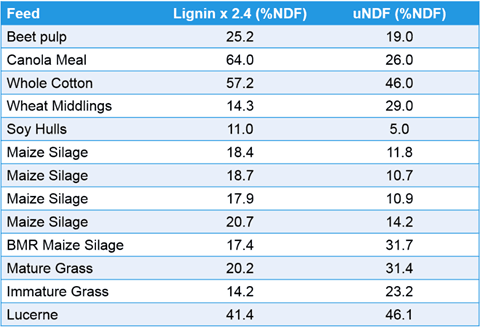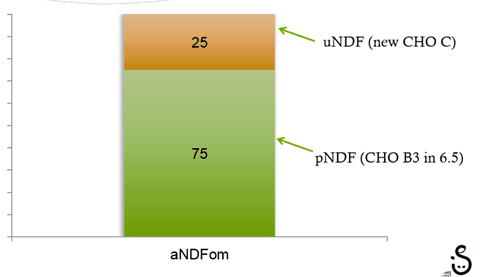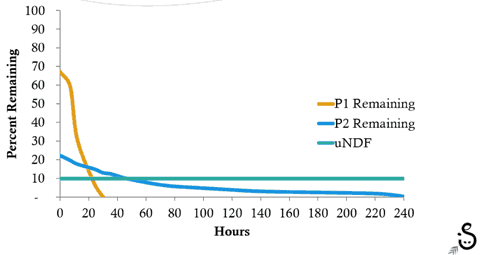The second area of fiber digestion we will discuss is uNDF. Fiber digestibility is very important to building dairy rations. We use it to classify forages; it is critical for determining DMI. Fiber levels of feed help us know rumen fill, rumination needs, and animal time budgets. Acronyms abound in fiber digestion, in recent years iNDF and uNDF have been used to describe the portion of fiber not digested in the rumen. To understand how these fiber components have replaced lignin as a measure of fiber digestibility (or indigestibility) it is necessary to understand what each represents.
Historically NDF indigestibility has been characterized by its relation to lignin. Dairy NRC (2001) is based on Weiss et al., 1992, using lignin/NDF. Previous versions of CNCPS have used Mertens’ PhD (1973) work, (2.4x lignin)/NDF. Studies have shown that the relationship of NDF to lignin x 2.4 is inconsistent and incorrect. Mertens’ worked only with Lucerne—and that did fit his premise.
An important part of the CNCPS model fiber digestion is characterization of digestibility and rates. Recent work by Raffrenato (2011) at Cornell introduced the concept of iNDF. A mathematical construct, iNDF represents that portion of NDF that is indigestible given an infinite amount of time in the rumen. As an industry, we have been using the concept of iNDF as an end point of digestion for the purpose of mathematically calculating the portion of potentially digestible fiber (pNDF). In this way the rate of digestion of NDF is calculated on only the potentially digestible fraction of NDF. Because iNDF is really just a theoretical number, Mertens proposed the term uNDF for undigestible NDF. Thus we derive the equation:
NDF-uNDF = pNDF
uNDF is the undigested NDF residue after fermentation a given length of time such as 24, 30, 48, 90, 120, or 240 hours. As with aNDFom, uNDF should be ash corrected to be biologically correct. Small amounts of mineral or ash can greatly affect the analysis and calculations of digestibility. For modeling purposes the uNDFom240 value provides the closest approximation of iNDF in forages. This relationship is more accurate and reliable than the old method of lignin x 2.4 for determining uNDF.

In using traditional Tilley-Terry in vitro fermentations, measurements of uNDF should be recorded at 3 time points to determine fast pools (P1), slow pools (P2) {CHO B3} , and uNDF {CHO C}. The three time points are used to calculate the rate for pNDF. Furthermore, roughages and non-roughages should not be measured at the same time points.
- Roughages will have time points of 30, 120, and 240 hours with 240 hours representing uNDF
-
Non-roughages will have time points of 12, 30, and 120 hours with 120 hours representing uNDF

The uNDF comes into play for determining rates of digestion of pNDF, which is a two pool system—fast pool and slow pool. Larger fast pool portions result in:
- Faster eating rate
- Faster Ruminal disappearance
- Higher intake
- More Ruminal buoyancy
In a recent article in Progressive Dairyman, Kurt Cotanch described the uNDF30 values to be a good measure of the NDF pool that passed through the rumen in 24 hours. A larger portion of this pool and uNDF results in:
- More “ballast”
- Greater chewing and rumination
- Lower intake
-
Slower eating speed
The multiple pool pNDF concept is graphically represented in this way:

The Dynamic kd Model incorporated into CNCPS v 6.5 determines kd for both pools and integrates them into one single kd using the calculations for rate and pools sizes using in vitro 30, 120, and 240 hour NDFD data. Furthermore, uNDF and intake appear to be highly correlated. Studies have shown that a Holstein cow will reach a steady state rumen uNDF level at about 4-5 kg. In order for her to eat more feed an equal amount of uNDF must exit the rumen through passage, as uNDF has 0% digestibility. Understanding the dynamics of uNDF presents opportunities in formulation, procurement, and manufacturing of feedstuffs. This aspect of the potential for diet adjustment through uNDF characteristics will be explored further in a future posting.
